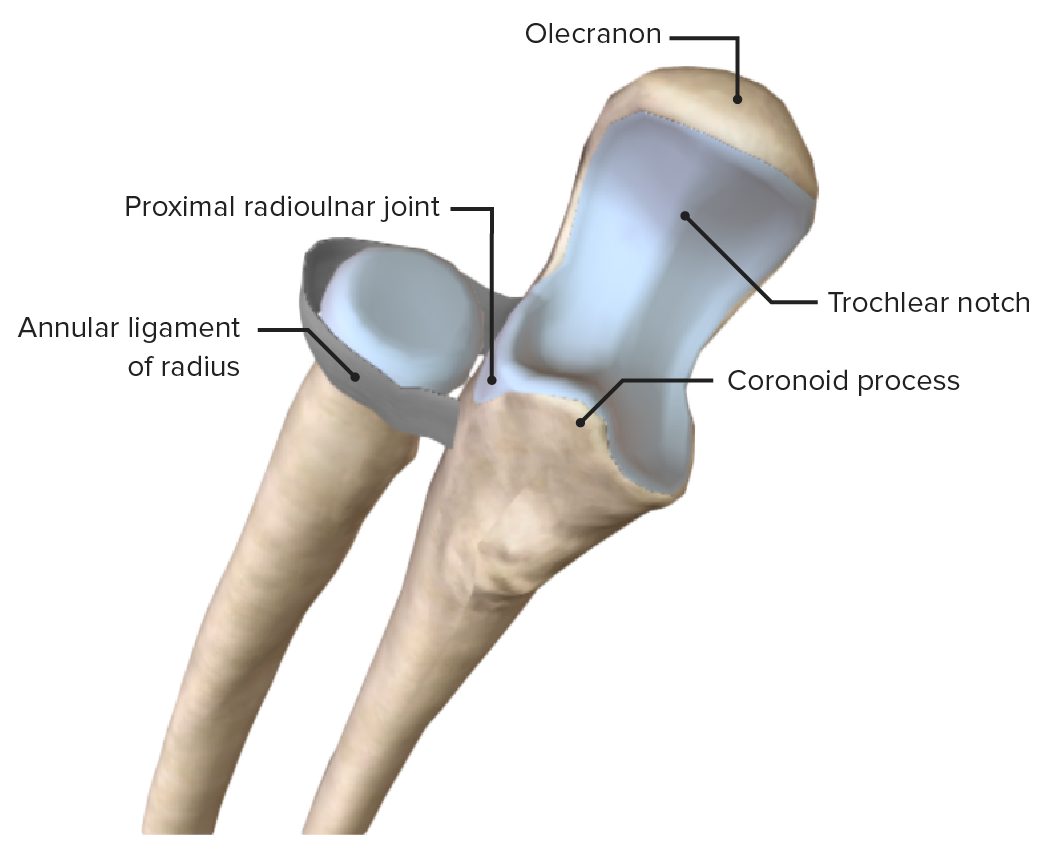Radial head subluxation, also known as nursemaid’s elbow or babysitter’s elbow, is a frequent injury seen in children under 4 years of age and describes the subluxation of the radial head under the annular Annular Dermatologic Examination ligament at the elbow. The injury primarily occurs when a child is pulled, swung, or lifted by 1 arm Arm The arm, or "upper arm" in common usage, is the region of the upper limb that extends from the shoulder to the elbow joint and connects inferiorly to the forearm through the cubital fossa. It is divided into 2 fascial compartments (anterior and posterior). Arm: Anatomy. Patients Patients Individuals participating in the health care system for the purpose of receiving therapeutic, diagnostic, or preventive procedures. Clinician–Patient Relationship present holding their injured upper limb in a guarded and pronated position. Diagnosis is made clinically and the condition is managed by a closed-reduction maneuver. Prognosis Prognosis A prediction of the probable outcome of a disease based on a individual's condition and the usual course of the disease as seen in similar situations. Non-Hodgkin Lymphomas is excellent when diagnosed in a timely manner.
Last updated: Dec 5, 2022
Radial head subluxation, also known as nursemaid’s elbow or babysitter’s elbow, describes the subluxation of the radial head under the annular Annular Dermatologic Examination ligament due to longitudinal traction on the forearm Forearm The forearm is the region of the upper limb between the elbow and the wrist. The term “forearm” is used in anatomy to distinguish this area from the arm, a term that is commonly used to describe the entire upper limb. The forearm consists of 2 long bones (the radius and the ulna), the interosseous membrane, and multiple arteries, nerves, and muscles. Forearm: Anatomy.

Articular surfaces of the elbow joint
Image by BioDigital, edited by Lecturio
Proximal radioulnar joint, featuring its main supporting ligament, the annular ligament of the radius
Image by BioDigital, edited by LecturioRadial head subluxation occurs when the child is lifted up by the arms with resultant axial Axial Computed Tomography (CT) traction of the forearm Forearm The forearm is the region of the upper limb between the elbow and the wrist. The term “forearm” is used in anatomy to distinguish this area from the arm, a term that is commonly used to describe the entire upper limb. The forearm consists of 2 long bones (the radius and the ulna), the interosseous membrane, and multiple arteries, nerves, and muscles. Forearm: Anatomy; e.g., while the child is being swung, lifted, or pulled by 1 arm Arm The arm, or “upper arm” in common usage, is the region of the upper limb that extends from the shoulder to the elbow joint and connects inferiorly to the forearm through the cubital fossa. It is divided into 2 fascial compartments (anterior and posterior). Arm: Anatomy.
Axial Axial Computed Tomography (CT) traction mechanism:
Other possible mechanisms:

Difference between a normal elbow and a nursemaid’s elbow
Image by Lecturio. License: CC BY-NC-SA 4.0History and presentation often lead to the diagnosis:
The entire affected upper limb/ clavicle Clavicle A bone on the ventral side of the shoulder girdle, which in humans is commonly called the collar bone. Clavicle Fracture should be examined.
History and physical examination with typical findings are sufficient to diagnose. Imaging may be useful when diagnostic challenges occur with atypical presentations or unknown history.
X-ray X-ray Penetrating electromagnetic radiation emitted when the inner orbital electrons of an atom are excited and release radiant energy. X-ray wavelengths range from 1 pm to 10 nm. Hard x-rays are the higher energy, shorter wavelength x-rays. Soft x-rays or grenz rays are less energetic and longer in wavelength. The short wavelength end of the x-ray spectrum overlaps the gamma rays wavelength range. The distinction between gamma rays and x-rays is based on their radiation source. Pulmonary Function Tests:
Closed reduction of a nursemaid’s elbow is the procedure of choice. The clinician Clinician A physician, nurse practitioner, physician assistant, or another health professional who is directly involved in patient care and has a professional relationship with patients. Clinician–Patient Relationship must be certain there are no fractures prior to manipulation.
Supination Supination Applies to movements of the forearm in turning the palm forward or upward. When referring to the foot, a combination of adduction and inversion movements of the foot. Examination of the Upper Limbs/ flexion Flexion Examination of the Upper Limbs technique:

Supination/flexion technique
Image by Lecturio.Hyperpronation technique:

Hyperpronation technique
Image by Lecturio.Patients Patients Individuals participating in the health care system for the purpose of receiving therapeutic, diagnostic, or preventive procedures. Clinician–Patient Relationship who fail the initial reduction maneuver: